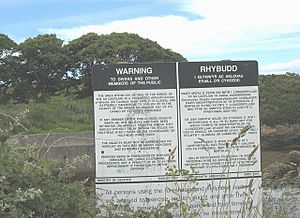SS Castilian (1919) facts for kids
Quick facts for kids History |
|
|---|---|
| Name | Castilian |
| Owner | Westcott & Laurance Line |
| Operator | Ellerman Lines |
| Port of registry | London |
| Builder | Sir Raylton Dixon & Co |
| Yard number | 618 |
| Launched | 26 June 1919 |
| Completed | 1919 |
| Identification | |
| Fate | wrecked on rocks 12 February 1943 |
| General characteristics | |
| Class and type | Shipping Controller Type C |
| Tonnage |
|
| Length | 331.3 ft (101.0 m) |
| Beam | 46.8 ft (14.3 m) |
| Depth | 23.2 ft (7.1 m) |
| Decks | 2 |
| Installed power | 310 NHP |
| Propulsion | triple-expansion steam engine |
| Speed | 11.5 knots (21.3 km/h) |
The SS Castilian was a British cargo steamship built in 1919. She was designed during the First World War to help carry supplies. Sadly, in 1943, while carrying dangerous explosives, she hit rocks near The Skerries, Isle of Anglesey, and sank.
Today, the Castilian is a dangerous shipwreck in the Irish Sea off the coast of North Wales. Because her explosive cargo is still there, it's against the law to go within 500 metres (1,600 ft) of the wreck. This rule is in place to keep people safe from the hidden dangers.
Contents
Meet the Castilian Ships
The Castilian was owned by a company called Westcott & Laurance Line, which was part of Ellerman Lines. Our Castilian was actually the second ship in the Ellerman fleet to have this name.
The First Castilian
The very first Castilian was bought by Ellerman in 1909. Before that, her name was Umbilo. During the First World War, in 1917, a German submarine sank her in the North Atlantic.
The Third Castilian
Ellerman built a third ship named Castilian in 1955. This ship had a long life and was renamed many times. In 1971, she was sold to owners in the Maldives and changed her name to Maldive Freedom.
Building and Life at Sea
The Castilian was built by Sir Raylton Dixon & Company in Middlesbrough, England. She was made using a standard design from the First World War. Her powerful engine, which used steam, was built by Richardsons Westgarth & Company.
When she was built, the government agency in charge of merchant ships, the Shipping Controller, gave all new ships names starting with "War." It's not clear if the Castilian was first named War Acacia or War Ocean.
The Castilian had a special UK official number, 143384. Until 1933, she used the code letters KCJF to identify herself. After 1934, her radio call sign became GBVX.
Sailing During World War II
During the Second World War, the Castilian played an important role. From September 1939 to June 1940, she sailed between Britain, Gibraltar, and other Allied ports in the Mediterranean Sea.
From July 1940 to November 1942, she made many trips across the North Atlantic Ocean. She would travel west in groups of ships called convoys and then return from Canada or the USA in other convoys. In November 1942, she sailed from Milford Haven to Gibraltar and returned in January 1943.
On February 11, 1943, the Castilian left Liverpool carrying a load of munitions, which are military explosives. She was sailing alone without any escort ships. The very next day, she hit rocks near The Skerries, Isle of Anglesey, and sank.
The Dangerous Wreck Today
In 1987, the Royal Navy spent several months clearing unexploded bombs from a nearby bay. These bombs were thought to have come from the Castilian wreck.
Because of the dangerous cargo still on board, the wreck site was officially made an exclusion zone in 1997. This means it is against the law to go scuba diving or even get within 500-metre (1,600 ft) of the wreck. This rule helps keep everyone safe from the explosives that are still there.


